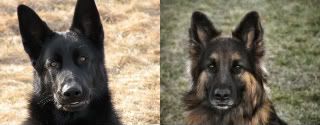Well, while not directly answering your question, I will say that IMO that ecollars have no place in training guardian dog pups. You correct the dog for interest in your animals and you'll create a dog who avoids your animals.
Well there you go.
I have responded to David's threads before...I'm not going to retype all I have already written on this subject.
I am glad that David is going to get help from the breeder, I hope they know what they are doing.
Since David isn't interested in hearing the following, I write it for the other readers.....
1. Pyrs will not be ready to guard till they are 2 yrs.
2. Pyrs need to be bonded to the flock when they are young, and idealy raised by an experienced guardian dog.
3. If there is no experienced guardian dog, the human must teach the dog what to do.
4. There is usually not much obedience done as this breed usually has very low drives all around. Tug can be used as well as marker training..however there is a strong argument that human interaction should be limited.
5. the pup will go through a phase where they get their "prey drive up" usually from 8mo to 11 mo where the dog will need to be isolated from any prey items...put it in the buck or billy goat pen..or in with the adult guardian llama or the donkey...you get the idea....put it in with a experienced guardian animal that will not put up with any crap....or if you don't have an experienced guardian animal...then a sizable adult animal that won't take any crap is a good option.
6. the dog is left again with minimal human contact till it gets over its self...lol..usually at about 1.5 years.
7.The dog is penned next to high value prey items...ex chickens and corrected for chasing........
!!!!!!!!!!!!!!!!!!!HEAR THIS!!!!!!!!!!!!!!!
Chasing is a big part of the behavior of guarding.
Our pyrs will regularly chase the goats or chickens to teach them who is boss and to keep their escape plans up to date....chasing is a vital part of the guarding process and correcting a dog too much can ruin it for working
The way it goes is this....coyote appears in the tree line...
pyr 1 barks....at the sound of the bark the chickens run/fly for a preselected (by the pyrs) defensible position...Did you hear that??? the pyrs train the chickens to run to the place of their choosing when they bark..actually all good guardians do this...not just pyrs......the way they do this is by chasing them and doing the border collie thing till the chickens are trained to obey..they same will apply for goats or whatever.
Pyr 2 runs off to do battle.
pyr 1..usually the bitch..circles back and stands guard over the animals in case the rest of the pack comes in from another angle.
Chasing is part of the package..when an animal is young, it will play with a chicken and chickens don't hold up to that well.
You can and will ruin the dog if you correct it off the chickens or goats..the usual way to handle it is to separate the young and untrustworthy dog away from the prey livestock.
It is general knowledge that pyrs won't work till they are 2.
It is general knowledge to keep chickens and baby goats/lambs well away from pyrs till they are at least 1.5 years old.
It is generally accepted to not mess with the dogs too much..just basic stuff....don't jump on me, don't mob me for your food that sort of thing...messing with them bonds them to YOU not the flock and they will always pick you.
Dogs that continue to chase after they are "grown up" are "canned" and a new pair is gotten.
This whole viewpoint outlined above is starting to be debated by a verrrrrrrrry well respected natural pastured hog farmer...he has bred his own line of dogs that work his pigs and land.
http://SugarMtnFarm.com/blog (total off shoot...but the things look like wolves..lol they have no wolf at all...but wow..)
On another forum he was disagreeing with the generally accepted "truths" that I outlined above.
I respect him greatly and would like to hear what he has to say on the subject.
So back to David.......no........I'm not gonna tell you how to use an e-collar on your babies....sry.
You could contact Walter @ sugar mtn farm and see if he has developed any methods that might help.
 Previous Topic
Previous Topic Index
Index Next Topic
Next Topic












 Top
Top





